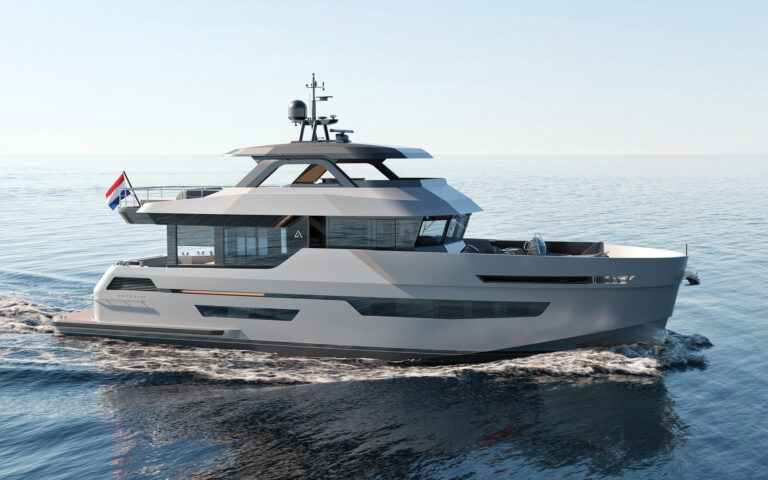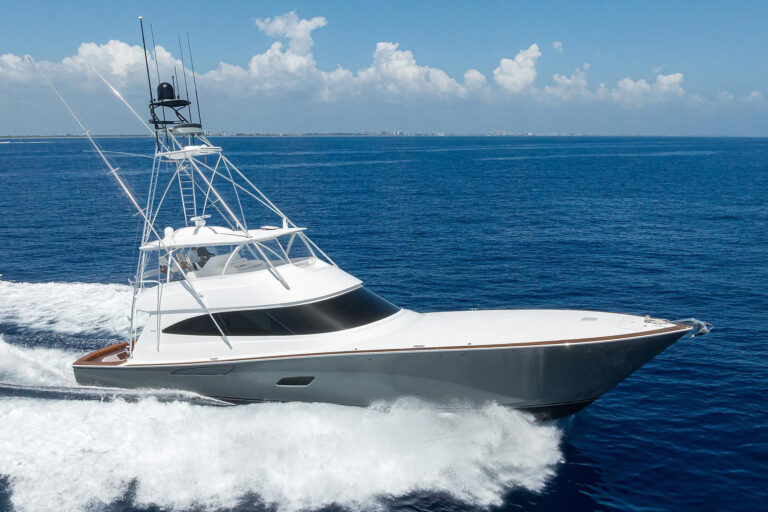If there’s one thing the Yachting staff has learned during decades of boat tests, it’s this: The quicker a day is planned for a boat test, the smoother the test is likely to be, and a smooth test usually involves a decent-or better than decent-boat.
The lesson rang true recently when I arranged a test of the new Cranchi 50 Mediterraneé. I called BMC Marine, Cranchi’s dealer in Pompano Beach, Florida, and was immediately put through to general manager Mike Engstrand. His enthusiasm about the boat was as intense as a driving summer rain, and he gladly arranged for us to get on board the following week. The positive impression continued when I met James Clayton of Cranchi in the BMC Marine parking lot. He was just as giddy.
Either these guys were punch drunk, or they were thrilled to be part of Cranchi and fully committed to the new boat. Thankfully, the latter proved true.
Cranchi began building boats in 1870 in Italy. Today, the company pumps out about 700 boats each year, from the Ellipse 21 to the 50 Mediterraneé. Under the tutelage of fifth-generation boatbuilder Aldo Cranchi, the builder quietly and methodically evolved from a modest boatbuilder into a high-tech, streamlined production facility.
“Aldo joined the business in 1970 and changed the company from a builder of family cabin cruisers to the current range,” Clayton said.
A product range of 13 models is hardly excessive for a builder this size, but the limited product offering is a deliberate company decision. Cranchi spends an exorbitant amount on research and development (several million dollars was spent on the 50) and keeps its resources focused on the few models it produces. The result is 13 well-executed models.
Development of the 50 began in 1997. A prototype was launched in 1999, but production did not begin until late 2000, after the prototype was tested for more than a year. This development cycle is relatively slow by industry standards. Similar-size production companies can usually bring a product to market within 18 months and will plan a life cycle for that product of about five years. Cranchi, however, figures on a product cycle between eight and 10 years for its new launches-a greater amount of time to recoup the large investment. In the end, buyers get an extremely well thought-out boat.
During my inspection of the 50, I saw a variety of clever details, good engineering and solid construction. Machinery, for example, is designed to be readily serviced and removed from the boat. “Everything must be accessible,” Clayton said. “If it can’t be accessed, we won’t put it in the boat.” This was no flippant sales pitch. Soft patches in the helm deck can be lifted if the engines and outboard fuel tanks need removal. Instead of installing one freshwater tank in a space that easily accommodates a single tank, Cranchi split a tank so the halves can be removed. Service panels throughout the interior expose the underside of deck hardware. The stainless-steel railing around the bow is assembled in sections, allowing smaller sections to be removed for repairs.
In the 50’s belly, every nut and bolt was fitted with a plastic cap. Exterior locker lids were finished with gelcoat on both sides. A 21/2-inch tube extending from the transducer far above the waterline surrounded the transducers for the depth sounder and speedometer. Should a transducer fail or should you be cursed with a bad O-ring, you won’t flood your boat. Dummy plugs were tethered to the hoses.
I could wax on for several pages about the engineroom. Exposed hose and wiring is routed through PVC conduits. A vacuum pump with a hose lets you suck dirt and grime from the bilges and engines. An automatic fire suppression system is standard. Sound insulation is wrapped around the hull sides, overhead and fuel tanks to minimize noise.
If you do a lot of your own maintenance or are inclined to keep your mechanics comfortable, you’ll appreciate this engineroom’s serviceability. Service points on the 480 hp Volvo TAMD 74P EDC diesels were inboard, and there was room to maneuver to the outboard side of the engines.
The nose cone for the tender garage protrudes through the after engineroom bulkhead, but unlike most other boats with tender garages, the 50’s cone can be quickly removed. Not only does this open up and ventilate the space, but it allows easy removal of the batteries. I still feel a sharp pain splintering my spine on occasion thanks to a game of Twister played trying to remove an 8-D battery from a motoryacht designed with no forethought.
Chilled-water air conditioning units by Marine Air Systems are mounted on their own racks in an after machinery compartment. Chilled-water units are usually found only on larger boats, but Cranchi recognized the benefits and made them standard on the 50. Generally, chilled water units are 30 percent more efficient than gas expansion units. They are also quiet, eliminating the sound from compressors that can disturb folks in the accommodations. In true Cranchi fashion, the builder installed in-line filters throughout the hose feeding the ducts. These, too, are easily accessed and cleaned to avoid dust buildup on the back side of hard-to-clean vents.
Also sure to impress is the Cranchi’s performance. Powered with the twin 480 hp Volvos, the 50 reached a top speed of 30.7 knots at 2650 rpm. Plowing out of the inlet at Pompano Beach, we met a few swells, applied a little port tab to counteract their offshore direction and met them head-on with a soft entry and dry decks. Not a wisp of salt water crept over the bow. Electronic controls for the Volvos responded quickly, with about a second’s lag time when applying the throttle. The delay was a hair more when backing down from wide-open throttle.
The hydraulic steering was tight and responsive. The 50’s helm is designed to integrate a full array of Raytheon electronics, all standard except the radar. It’s a clean, streamlined dash with a car-like, user-friendly setup. The single-lever controls are angled toward the driver, placed exactly where your arm reaches. Engine gauges and the Ritchie compass are directly in your line of sight, keeping your eyes aimed ahead of you, not down.
The helm seat can be electronically moved up and down, forward and aft. The companion seat swings 180 degrees toward the settee abaft. It also moves inboard, exposing a teak step allowing the driver to quickly step over the windshield to the starboard side deck when docking. While driving, I found myself standing with the seat kicked back. While sitting, my line of sight was just under the windshield frame. (I’m about 5 feet, 9 inches tall, so if you break the 6-foot mark, you may find the frame directly in front of you, blocking your view while seated.)
The remainder of the helm deck was well finished. The cushions have a Textaline mesh material on their underside to let the foam breathe. A wet bar with grill, ice maker, glass stowage and refrigerator will complete any sunny afternoon on the water. The bar’s level of glasswork is indicative of the entire boat. Shaped with sumptuous curves and rounded corners, the bar shows no hints of porosity or blemishes, just flawless glasswork.
A U-shape settee surrounds a folding dining table mounted on the enginerooom hatch. While we ran at speed, the table vibrated as the hatch moved underneath. Positive locking devices or dogs on two of the hatch’s corners would help. The arrangements plan is fairly standard, with three staterooms, two heads, a saloon and a straight galley. Cherry wood is used throughout the interior, finished with high-gloss varnish.
Cranchi makes the brushed aluminum electrical panel. The breaker designations are etched, and each includes an LED indicator light. The panel is accessible from the starboard guest cabin, behind a full-length door. All wiring is neatly harnessed and labeled, and the wiring schematic hangs inside the door. No more flipping through manuals.
As with most things Italian, special touches on the Cranchi, including leather-wrapped door handles, Alcantara overhead and ceiling, and Corian counters, create a sense of timeless style.
The standard equipment list is extensive and includes a CD/stereo in each cabin, a full set of dishes and cutlery, a bow thruster, a generator, a retractable boarding ladder, a GPS, a chart plotter, an autopilot, a windlass, a galvanic isolator and VacuFlush MSDs.
What amazed me most was the price. Fully equipped, the Cranchi 50 is less than $600,000. “If Cranchi had a board of directors to answer to, this would be a million-dollar boat,” Engstrand said.
Mostly, buyers can thank Aldo Cranchi. He built a high-tech factory that uses robotics to cut glass and spray molds, which streamlined production on the line in Detroit-like fashion. Cranchi builds its 700 boats per year with about 300 workers-half as many as some builders producing a similar number of boats.
The savings are passed on to you.
Cranchi, (305) 867-4355; fax (305) 867-4350.









